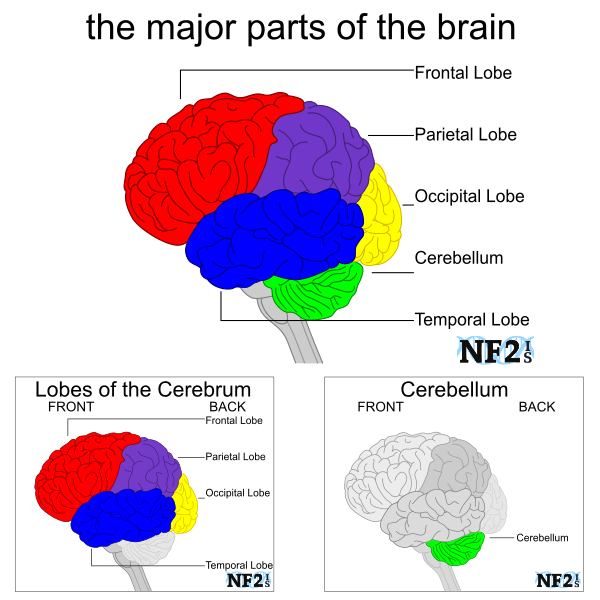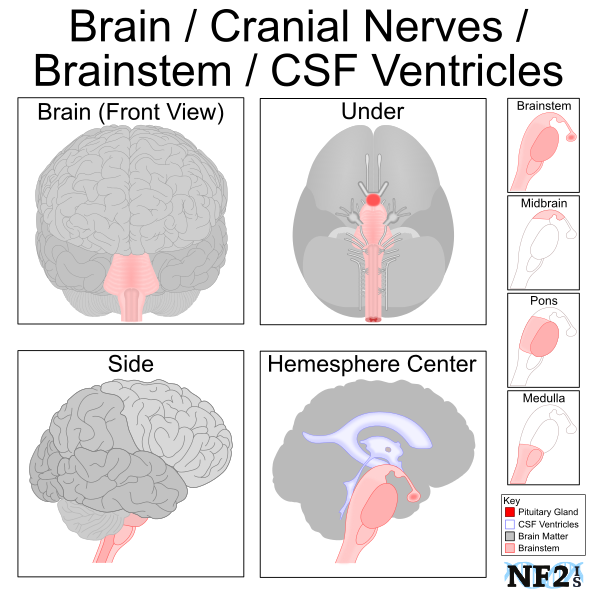Home > NF2 Facts & Information > Damage - Tumors and Schwann Cells >
Brain Issues
Last Updated: 07/14/20
Index

- Potential Brain Tumor Growth Issues
- Brainstem Compression/
traumatic brain stem injury (TBSI) - Ataxia Ataxia
- Cerebrospinal-Fluid Flow Issues
- Epilepsy and Seizures
- Strokes
- Brain Trauma Issues: Cognitive Issues
- The Human Brain
- Functions by Region
- Additional Matter
- Gender
- Adaptability (Neuroplasticity)
Brain Growth Potential - Sources
1. Potential Brain Tumor Growth Issues
When benign (noncancerous) tumors of either schwannoma or, meningioma grows in the brain from; neurofibromatosis type 2 (NF2), or from spontaneous tumor development; tumor growth is typically slow, at a rate of 1mm a year. The exact rate of growth of tumor varies from person, and tumor by tumor in the same person for different reasons.
This slow growth allows the brain time to adjust to enlarging tumors; this can prevent brain trauma due to growth alone and be an advantage because the expansion of tumors can occur for many years without requiring treatment.
Some of the brain issues that can occur may be the result of; 1) rapid or increased growth rate, 2) surgery, 3) radiation/radiotherapy, 4) tumor drug-treatments (clinical trial chemotherapy molecular targeted tumor therapy).
A variety of tumor types can grow in patients with NF2 and cause damage to the central nervous system (CNS); brain and spinal cord. Tumors can also grow and cause damage in other areas. While the most common issues for individuals with NF2 involve cranial nerves, which are the nerves that branch out from the brainstem, other issues can develop including:
- Brainstem Compression (upper-spinal cord)/traumatic brain stem injury (TBSI)
- Ataxia
- Cerebrospinal-fluid (CSF) Flow Issues
- Epilepsy and Seizures
- Strokes
- Brain Trauma Issues (Cognitive Issues) - Attention, Thinking, or Memory Problems

|

|

|
1. Brainstem Compression (Upper-spinal cord)/traumatic brain stem injury (TBSI)
https://www.tbi.org/seizures/what-is-brain-stem-injury.html
2. Ataxia
Ataxia is a loss of full control of motor activities as a result of damage to the brainstem. The movement may be abnormal, uncoordinated, ataxic gait (staggering uncoordinated gait), and other bodily movements.[merriam-webster dictionary, & dictionary.com]
Ataxia may result from abnormalities in different parts of the nervous system, including the central nervous system (brain and spinal cord) and peripheral nervous system (roots and nerves that connect the central nervous system to muscles, skin, and the outside world). When patients experience abnormal walking or uncoordinated use of their hands or arms, dysfunction of the cerebellum is often responsible.[ John Hopkins]
Persistent ataxia usually results from damage to the part of your brain that controls muscle coordination (cerebellum). Many conditions can cause ataxia, including alcohol abuse, certain medications, stroke, tumor, cerebral palsy, brain degeneration and multiple sclerosis. Inherited defective genes also can cause the condition. [ Mayo]
3. Cerebrospinal-fluid (CSF) Flow Issues
Cerebrospinal-fluid (CSF) is a clear and colorless fluid that needs to continuously move through a membrane that surrounds the Central Nervous System; brain and spinal cord. CSF needs to continuously flow from brain to spine and as tumor burden increases, where the flow stops can be fatal. There are warning signs that this is happening and different treatment options.
Tumor growth can cause issues with the necessary flow of CSF from the brain into the spine. There are two forms of Cerebrospinal-fluid flow issues that might develop; intracranial pressure (obstructive hydrocephalus) and CSF leak (Intracranial Hypotension).
4. Epilepsy and Seizures
Epilepsy is a brain disorder in which a person has repeated seizures over time. Seizures are episodes of disturbed brain activity that cause changes in attention or behavior.
The likely causes of Epilepsy for individuals with NF2 include:
- Brain Tumor: Chances increase as tumor mass increases and causes pressure on brain matter
- Abnormal blood vessels in the brain
- Stroke or transient ischemic attack (TIA)
- Brain Abscess - Infections (bacterial or fungal)
- Brain Tissue Damage
- Radiation Therapy/Radiosurgery: Brain Cell Necrosis
- Surgery: Glial Scars
- Medications including many used to manage tumor growth
5. Strokes
A stroke occurs when the blood supply to the brain is interrupted or reduced; this deprives your brain of oxygen and nutrients, which can cause your brain cells to die.
Strokes are commonly the result of blockage of an artery in the chest, but for people with NF2 are more commonly the result of an artery in the brain from either a brain tumor or multiple tumors.
A stroke may be the result of a blocked artery (Ischemic Stroke) or leaking or burst blood vessel (Hemorrhagic Stroke). Some people may experience a temporary disruption of blood flow through their brain (transient ischemic attack (TIA)).
Symptoms of strokes can include a problem with:
- walking
- speaking
- understanding
- sudden paralysis of; face, arm, or leg
- vision in one (1) or both eyes
- a severe headache
- dizziness
- nausea
6. Brain Trauma Issues (Cognitive Issues): Attention, Thinking, or Memory Problems
Cognitive issues are brain issues the result of brain cell damage and can differ depending on the regions of the brain the issue lies. People with NF2 are at risk to potentially develop cognitive issues but only as the result of brain trauma from:
- fast-changing in tumor size
- brain surgery
- radiation/radiotherapy treatments; Gamma Knife, CyberKnife, or Proton Therapy
Cognitive issues from tumor growth can be temporary particularly if the result of either tumor growth, or surgery. However; cognitive issues from a radiation or radiotherapy treatment of some sort, are likely a permanent issue.
The tumor drug treatments in clinical trials can result in cognitive problems also referred to as cognitive dysfunction or "chemo brain," occur when a person has trouble processing information, which includes mental tasks related to attention span, thinking, and short-term memory.[ASCO, 2013]
Cognitive Issues from; tumor growth, brain surgery, radiotherapy treatments, or tumor drug-based treatments, may include:
- trouble concentrating, focusing or paying attention
- mental fog or disorientation
- the difficulty with spatial orientation
- memory loss or forgetting certain things, especially names, dates, or phone numbers
- problems with understanding
- difficulties with judgment and reasoning
- impaired math, organizational, and language skills; organize thoughts, find the right word, or balance a checkbook
- problems multitasking
- processing information slower
- behavioral and emotional changes; irrational behavior, mood swings, intense anger or crying, or socially unsuitable behavior
- confusion
2. The Human Brain
i. Functions by Region
- Frontal Lobe: The frontal lobe is responsible for; thinking, reasoning, conceptualization, planning, attention, memory, motivation, and parts of speech.
- Parietal Lobe: The parietal lobe is responsible for; movement, orientation, calculation, recognition, language processing, and perception of sensory information.
- Occipital Lobe: The occipital lobe is the visual processing center of the brain. Different areas of the occipital lobe affect different areas in the visual field in the eye on that side of the brain.
- Temporal Lobe: The temporal lobe is responsible for the formation of; long-term memory, auditory perception, understanding speech and vision, retention of visual memories, processing sensory input, emotion, and deriving meaning.
- Cerebellum: The cerebellum is primarily responsible for motor control. All physical movement
ii. Additional Matter
- White Matter: Manages the distribution of action potentials, acting as a relay and coordinating communication between different brain regions.
- Grey Matter: Processing and Cognition - muscle control, sensory perception including; seeing and hearing, memory, emotions, and speech.
- Left Brain: Controls the right part of the body. In the brain controls language and logical functions including math.
- Right Brain: Controls the left part of the body. In the brain controls creativity, music, visual imagery, and recognition.
iii. Gender
There are two major regions of the brain Cerebellum and the Four Lobes that make up the Cerebrum (aka Telencephalon). Each of these regions of the brain is responsible for different functions.
Some additional thing that could determine what is or is not affected includes damage to the following:
Men and women access different parts of their brains for the same tasks. Women have more White Brain Matter. Men have more Gray Brain Matter.
3. Adaptability (Neuroplasticity) - Brain Growth Potential
Neuroplasticity; brain plasticity, neural plasticity, or brain malleability
"Neuroplasticity allows the neurons (nerve cells) in the brain to compensate for injury and disease and to adjust their activities in response to new situations or changes in their environment... Brain reorganization takes place through mechanisms such as "axonal sprouting" in which undamaged axons grow new nerve endings to reconnect neurons whose links were injured or severed. The brain compensates for damage in effect by reorganizing and forming new connections between intact neurons. However, to reconnect, the neurons need stimulation through activity." [MedicineNet, 2017]
From birth, the brain continues to develop and continues to do so while an individual encourages their brain to continue to learn. As people grow older, brain development slows down; believed to start when people are over the ages of eighteen (18) - twenty (20), but tumor damage from growth or surgical removal of a tumor can result in the advantage of Neuroplasticity which offers the ability to develop after early ages of life.
Neuroplasticity offers an opportunity for brain expansion to allow an ability to learn a language due to hearing loss like; sign language, or the brain learning to work to understand how to with an Auditory Brainstem Implant (ABI).
Encouragement of brain development with the education of new things can help recovery from Cognitive Issues resulting from; brain tumor growth, or brain surgery.
The butterfly is the symbol for NF2 for the connection of its adaptability.
4. Sources
-
American Society of Clinical Oncology (ASCO). "Attention, Thinking, or Memory Problems." (June 2013)
Source: http://www.cancer.net/navigating-cancer-care/side-effects/attention-thinking-or-memory-problems - University of Michigan. "Brain-training To Improve Memory Boosts Fluid Intelligence." ScienceDaily. ScienceDaily, (6 May 2008.) Source: https://www.sciencedaily.com/releases/2008/05/080505075642.htm
-
National Science Foundation. "Plastic Brain Outsmarts Experts: Training Can Increase Fluid Intelligence, Once Thought To Be Fixed
At Birth." ScienceDaily. ScienceDaily, (6 June 2008).
Source: https://www.sciencedaily.com/releases/2008/06/080605163804.htm -
Hunt, Andy. Pragmatic Bookshelf. "Pragmatic Thinking and Learning - Refactor Your Wetware."
https://pragprog.com/book/ahptl/pragmatic-thinking-and-learning -
Physio-pedia "Neuroplasticity"
Source:
https://www.physio-pedia.com/Neuroplasticity -
MedicineNet. "Medical Definition of Neuroplasticity" (2017)
Source: http://www.medicinenet.com/script/main/art.asp?articlekey=40362 -
Kim, Hun Joo. "The prognostic factors related to traumatic brain stem injury." Journal of Korean Neurosurgical Society 51.1 (2012): 24.
https://www.ncbi.nlm.nih.gov/pmc/articles/PMC3291702/ -
Mayo Clinic "Ataxia"
https://www.mayoclinic.org/diseases-conditions/ataxia/symptoms-causes/syc-20355652 -
John Hopkin "What is Ataxia?"
https://www.hopkinsmedicine.org/neurology_neurosurgery/centers_clinics/movement_disorders/ataxia/conditions/index.html - Merriam Webster Dictionary. "Ataxia." https://www.merriam-webster.com/dictionary/ataxia
- roche lexikon. "Exterior of the base of the skull; inferior view; the arrow is in the hypoglossal canal." (2000) https://web.archive.org/web/20120722052131/http://www.tk.de/rochelexikon/pics/s34257.000-1.html


 |Google Play
|Google Play